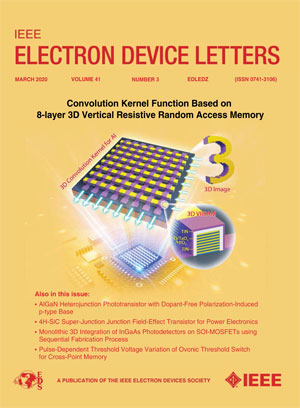用于直接光谱转换的像素化阵列薄膜光电集成器件
IF 4.1
2区 工程技术
Q2 ENGINEERING, ELECTRICAL & ELECTRONIC
引用次数: 0
摘要
光电混合集成技术(OHIT)有望满足光通信系统中对直接光谱信号转换日益增长的需求,特别是在光子作为首选介质的大数据时代。本研究设计和制造了一种光电集成器件,该器件采用像素化阵列薄膜,集成了光伏(PV)组件和有机发光二极管(OLED)组件,用于直接光谱转换,面积为174.2 cm2,特别适合在各种实际场景中大规模部署。采用抗溶剂喷涂技术和机械划痕法分别保证大面积光伏器件阵列的结晶均匀性和模块结构优化。在串联顶发射OLED (te -OLED)的电荷产生层(CGL)中集成超薄银势垒层,以提高光-光转换效率。在AM1.5太阳模拟器20%功率的严重弱光条件下,集成器件最大EQE*可达10.43%,亮度*可达2032.33 Cd/m2。即使在如此具有挑战性的光条件下,集成器件也能促进直接光谱转换,这大大拓宽了其潜在应用,例如可见光通信、成像。本文章由计算机程序翻译,如有差异,请以英文原文为准。
An Optoelectronic Integrated Device Featuring Pixelated Array Thin-Film for Direct Spectral Conversion
Optoelectronic hybrid integration technology (OHIT) is poised to meet the escalating requirements for direct spectral signal conversion in optical communication systems, particularly in the context of the big data era where photons are the medium of choice. This work presents the design and fabrication of an optoelectronic integrated device featuring pixelated array thin-film for direct spectral conversion integrating a photovoltaic (PV) component and an organic light-emitting diode (OLED) component, spanning an area of 174.2 cm2, making it particularly suitable for large-scale deployment in various practical scenarios. An anti-solvent spraying technique and a mechanical scribing method are employed to ensure the crystallization uniformity and module structural optimization for large-area PV device array, respectively. An ultra-thin Ag barrier layer is integrated into charge generation layer (CGL) of the tandem top-emission OLED (tTE-OLED) to enhance the optical-to-optical conversion efficiency. The integrated device maintains a maximum EQE* of 10.43% and a luminance* of 2032.33 Cd/m2 under severely low-light conditions of 20% power of AM1.5 solar simulator. The ability of the integrated device to facilitate direct spectral conversion even under such challenging light conditions significantly broadens its potential applications, such as visible light communication, imaging.
求助全文
通过发布文献求助,成功后即可免费获取论文全文。
去求助
来源期刊

IEEE Electron Device Letters
工程技术-工程:电子与电气
CiteScore
8.20
自引率
10.20%
发文量
551
审稿时长
1.4 months
期刊介绍:
IEEE Electron Device Letters publishes original and significant contributions relating to the theory, modeling, design, performance and reliability of electron and ion integrated circuit devices and interconnects, involving insulators, metals, organic materials, micro-plasmas, semiconductors, quantum-effect structures, vacuum devices, and emerging materials with applications in bioelectronics, biomedical electronics, computation, communications, displays, microelectromechanics, imaging, micro-actuators, nanoelectronics, optoelectronics, photovoltaics, power ICs and micro-sensors.
 求助内容:
求助内容: 应助结果提醒方式:
应助结果提醒方式:


